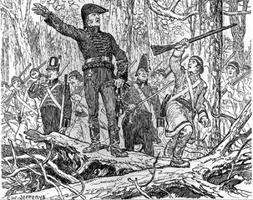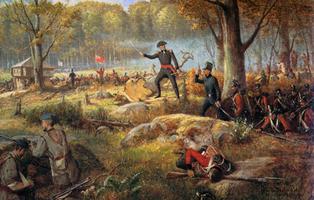Battle of Châteauguay
One of the least destructive skirmishes of the War of 1812 in terms of casualties, the Battle of Châteauguay was also one of the most detrimental to American war plans and one of the most important for the development of Canadian nationalism. Fought 25-26 October 1813 along the marshy shores of the Châteauguay River near Montréal, it was initiated by American general Wade Hampton. With approximately 3000 troops, Hampton intended to invade Lower Canada as part of a large-scale operation to capture Montréal, in conjunction with General James Wilkinson, who was approaching from the west along the St. Lawrence (see Battle of Crysler's Farm).
Candian Defences at Châteauguay
Hampton's army was met by a smaller, all-Canadian force of Voltigeurs, fencibles, militia, and several Kahnawake warriors, under the command of French-Canadian lieutenant-colonel Charles-Michel d'Irumberry de Salaberry. The American loss effectively ended any serious threat against Montréal. For the defenders, who were outnumbered and, for the first time, fighting without British support, this skirmish became a source of enormous pride.
From the outset, Hampton's cause was fraught with challenges. Approximately 1000 of the New York militia who were a part of his army refused to cross the border, and during the battle itself, several of his officers were seen abandoning their men and positions for safer ground. The Canadians had lodged behind extremely well-constructed defensive works, and the amount of noise emanating from them - shouts, cheers, and bugling, deliberately produced to cause confusion - made it difficult for Hampton to ascertain how many members of the enemy's forces he faced.
Failed American Strategy
Initially, the Americans' plan of attack seemed promising, if precarious. Finding the Canadian defences wedged between the river on the east, and a swamp to the west, Hampton hired guides to lead a brigade (under Colonel Robert Purdy) northward, where they would position themselves behind Salaberry's barricade. Hampton and a second brigade under General George Izard would then commence a frontal attack on the Canadian position.
What looked good on the map, however, was a disaster in execution. On the evening of 25 October, Purdy and 1500 men set out to find their way behind the Canadian defences. When the guides proved less than reliable, the troops found themselves lost and meandering in the woods, making very little progress. Meanwhile, Hampton received a communication from the secretary of war, John Armstrong, that winter barracks were being constructed for his men; Hampton took this news to mean that Washington did not intend to support the invasion. Disheartened, but unable to recall Purdy, he went ahead with his plan the following morning.
Victory for the Canadians
The skirmish itself lasted several hours and involved intense and repeated thrusts and volleys on each side. But because Purdy's men had not been able to flank the Canadian defences, the forward assault on the barricade was not nearly as effective as Hampton and Izard had hoped. Purdy's men were scattered, under fire from snipers, and lacked any coordinated leadership; many of them abandoned the fight. The Americans were further disadvantaged by their weapons, which were loaded with notoriously inaccurate "buck-and-ball" ammunition, most of which ended up lodged in the surrounding trees. By three o'clock that afternoon, recognizing that the enterprise had failed, Hampton ordered his men to withdraw. Later reports described this retreat as panicked and fearful, particularly for Purdy's men, as they were pursued by Aboriginal warriors throughout the following night.
Although the encounter at Châteauguay was not as bloody as many battles fought during this war, the loss of life and injuries sustained should not be dismissed. The Americans suffered 23 killed and 33 wounded, while 29 men were declared missing. Salaberry's troops fared better (no doubt because of their well-constructed defences); they reported two killed, 16 wounded, and four missing.

 Share on Facebook
Share on Facebook Share on X
Share on X Share by Email
Share by Email Share on Google Classroom
Share on Google Classroom







